|
|
||

|
||
|
|
||
|
|
||
|
|
||
|
|
||
|
|
||
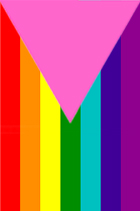
History: Amsterdam Gay Pride
One of the biggest highlights in Reguliersdwarsstraat are the street parties to celebrate the annual Amsterdam Gay Pride. This event was first held in 1996 and was initiated by people from gay dancing Havana in Reguliersdwarsstraat.
Despite its name, the Amsterdam Pride has a different origin than many other Gay Prides around the world, which usually mark the Stonewall riots. In the Netherlands, however, that tradition is being continued by another event, which is called Pink Saturday.
> See also: Current program
updated: 04-09-2021
The origins
The celebration of Gay Pride arose from the Stonewall riots, which began on Saturday morning, June 28, 1969, when police raided the Stonewall Inn gay bar on Christopher Street in New York.
As usual, men suspected of wearing women's clothes were taken apart for arrest, but when the police also harassed lesbian visitors, the atmosphere in the bar changed. When a lesbian butch tried to escape her brutal arrest outside, bystanders started attacking the police.
This mainly happened by homeless gay youth from the bar and from the neighborhood, as they had enough of such humiliating police activities. Also actively involved were the black drag queens Marsha P. Johnson and Zazu Nova, who also took part in the riots the next day. Also on Wednesday, about 1000 people participated.
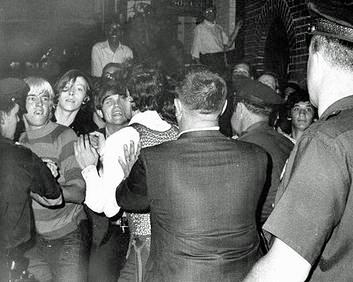
Police battling youths outside Stonewall Inn
(photo: Joseph Ambrosini/New York Daily News)
Gay Liberation Day
These riots were commemorated exactly one year later, on June 27 and 28, 1970, in New York, Chicago and Los Angeles with the very first Gay Liberation or Gay Freedom demonstrations, which not only had a serious, but also a joyful character so that both participants and spectators could get a positive experience from it.
In the following years, such parades were organized in more and more American cities. In Europe the first gay demonstrations were held in 1972 in London, in 1977 in Stockholm, in 1978 in Zurich and in 1979 in Bremen and Berlin. In the 1980s, the terms 'Liberation' and 'Freedom' were gradually replaced by 'Pride'.
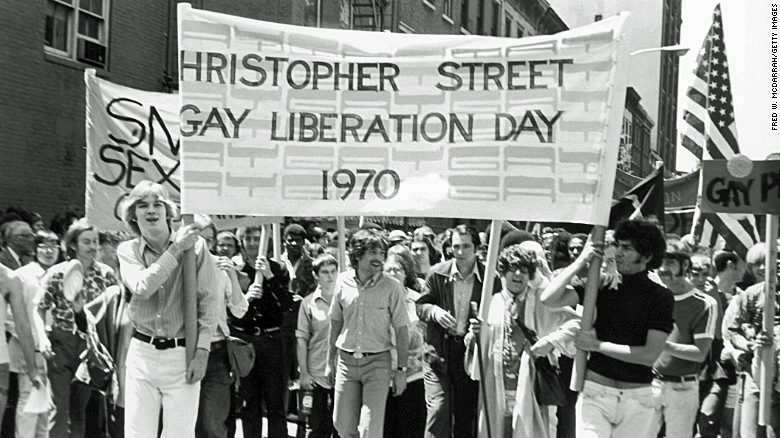
The very first Gay Pride in New York City, June 28, 1970
(photo: Fred W. McDarrah/Getty Images)
The Netherlands
In the Netherlands, there had already been two small gay demonstrations in 1969 and 1970, but the Dutch gay rights organisation COC initially didn't want to organize a Gay Pride march like in the US. COC saw gay people as normal and decent human beings, so in their view there was no need to demonstrate their sexuality.
Only after the organisation changed its policy in the mid-1970s, the first Dutch "Gay Liberation and Solidarity Day" or "Gay Pride Day" was be held in Amsterdam on June 25, 1977. This manifestation was organized by the International Lesbian Alliance and was mainly directed against the American anti-gay activist Anita Bryant.
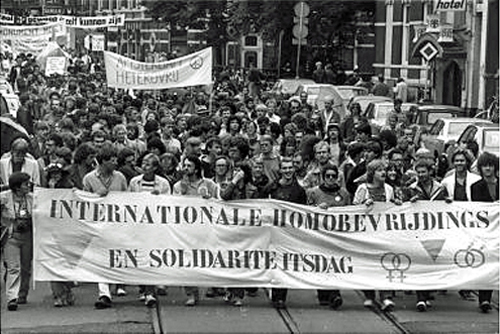
Demonstration during the International Gay Liberation
and Solidarity Day, also known as Pink Saturday.
Here in Amsterdam on June 28, 1980
(photo: Collection Spaarnestad)
Pink Saturday
In 1979 this event, held on the last Saturday of June, was renamed into Pink Saturday (Dutch: Roze Zaterdag), and since 1981 it is held in a different city each year, as outside Amsterdam there was more need for emancipation. This makes this Dutch Gay Pride atypical compared to most other Prides elsewhere in the world.
Pink Saturday was back in Amsterdam again in 1994, as the final day of the EuroPride week. There was a traditional march through the streets, but on some of the bandwagons lesbians engaged in explicit sexual acts, which shocked some of the 67.000 visitors.
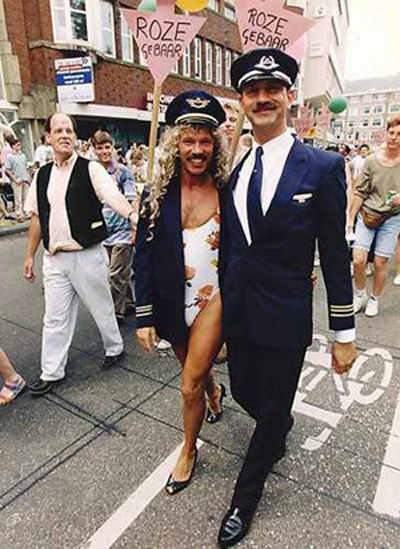
Participants in the Pink Saturday march
in Amsterdam, June 25, 1994
(ANP PHOTO/Raymond Rutting|CC BY-NC-ND 4.0)
Amsterdam Pride
Because at the same time the attractiveness of Amsterdam's gay scene was declining, a group of people from the popular and trendy gay dancing Havana in Reguliersdwarsstraat came up with a new event: Amsterdam Pride.
This Pride was different from Pink Saturday and many other Gay Prides, as it had no political or emancipatory goal; it was purely about celebrating the freedom and diversity of Amsterdam and keeping the city an attractive destination for gay tourists.
The Amsterdam Pride had to be an open and spontaneous celebration in which no distinction was made between gay and straight, just like the big parties that have been organized in Reguliersdwarsstraat since the 1980s.
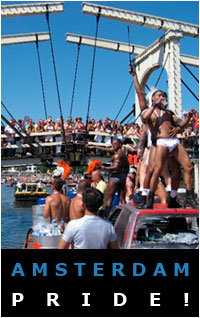
Two Gay Prides
Since then, there are actually two Gay Prides in the Netherlands: the older one, which is held in June in a different city every year and is called Pink Saturday; and the newer one, which is held in August in Amsterdam.
Although the Amsterdam Pride wasn't in the tradition of the Stonewall riots, the fact that it is held in the capital city and is called "Amsterdam Pride" made that for most people this event became the main Dutch Gay Pride, like those in other capitals all over the world.
With its more regional focus and less issues to fight for, the original Pink Saturday wasn't able to attract as much attention and the number of its visitors ultimately stuck around 40.000, while the Amsterdam Pride grew to several hundred thousand visitors.
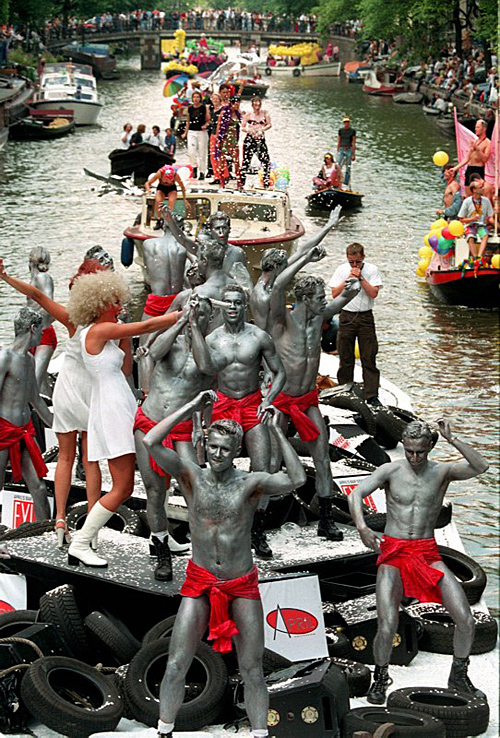
The boat of April and Exit from the Canal Parade
of the Amsterdam Pride in 1996
(ANP PHOTO/Hans Steinmeier|CC BY-NC-ND 4.0)
Canal Parade
The Amsterdam Pride was unique, because instead of a march with trailers through the streets, there's a parade of boats over some of the city's world famous canals. Right since the beginning in 1996, there were also boats participating that were manned and decorated by the big gay venues from Reguliersdwarsstraat.
> See: Reguliers boats in the Canal Parade (in Dutch)
Besides the Canal Parade, Amsterdam Pride was also celebrated with street parties in the city's gay streets: Warmoesstraat, Halvemaansteeg, Kerkstraat, Paardenstraat and Reguliersdwarsstraat, where the party was initially centered around gay dancing Havana:
The Canal Parade was so successful, that later on the concept was copied in a few other Dutch cities: since 2010 there's a small floating Gay Pride parade in Alkmaar as well as in Utrecht since 2017. A similar parade over the local canals was held during the Pink Saturday of 2017 in Den Bosch and during Pride Leeuwarden in May 2018.
Gay Games
In 1998, the Canal Parade marked the start of the fifth edition of the Gay Games, which were held in Amsterdam for the first time. With over 14.000 mainly gay athletes and some 250.000 visitors from all over the world, this was the by then biggest gay event held in the Netherlands.
The Gay Games brought an atmosphere of solidarity and freedom to the city, which for many gay people remains unchallenged until the present day. The event was also celebrated with parties in the gay streets Warmoesstraat, Halvemaansteeg and of course Reguliersdwarsstraat:
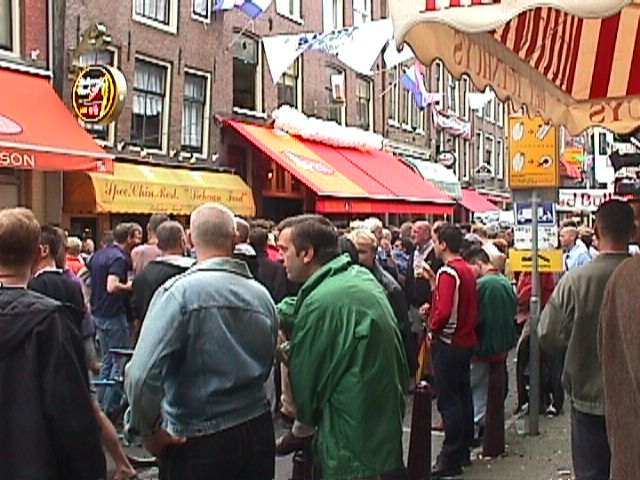
Street party in Reguliersdwarsstraat during the 1998 Gay Games
(Photo: Gaygam.tripod.com - Click to enlarge)
In the week of the Gay Games there was also a gay & lesbian open air cinema at Nieuwmarkt and a range of gay related exhibitions and presentations. Together with smaller gay sports events, these cultural activities also became part of the annual program of the Amsterdam Pride.
As the highlight of the Pride, the Canal Parade was so successful, that already since 1998, the number of boats had to be maximized at 80. The number of visitors rocketed from 20.000 in 1996 to 250.000 in the early years of the new millennium, making it one of Amsterdam's largest public events.
Gay life in Reguliersdwarsstraat also florished and culminated in what is generally remembered as the greatest open air party of all: the performance of Kylie Minogue during Gay Pride 2000:
dwarsstraat, during Gay Pride 2000
(video: MVS Gaystation)
New organiser
Since 1996, the Amsterdam Pride had been organised by Gay Business Amsterdam (GBA), an association of gay businesses, led by Ernst Verhoeven, Siep de Haan and Peter Kramer. However, in 2006 GBA was confronted with such a rapid increase in the security costs, that they could no longer get the event financed. Therefore, the city granted the permission for the Pride to a new foundation called ProGay.

ProGay was led by Frank van Dalen, who was also chairman of gay rights organisation COC. He had a more commercial approach and at the same time gave the event a political dimension, the latter making it resemble the Pink Saturday. In 2008 it was the first time the mayor of Amsterdam and three cabinet ministers attended the Canal Parade.
Logo & Themes
Because the name "Amsterdam Pride" was owned by the previous organiser GBA, ProGay renamed the event into "We Are - Amsterdam Gay Pride" and also a logo was created: a pink flower consisting of the characteristic canal houses:
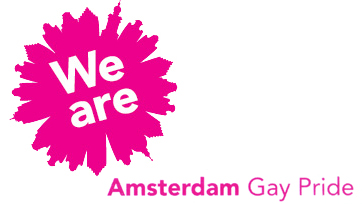
ProGay continued to provide each edition of the Amsterdam Gay Pride with a theme, which is especially meant to be visualized by the boats participating in the Canal Parade. These themes were:
|
- 2006: Rembrandt - 2007: Music & Dance - 2008: Religion - 2009: Extraordinary - 2010: Celebrate - 2011: All Together Now - 2012: On The Move - 2013: Reflect |
- 2014: Listen - 2015: Share - 2016: Join - 2017: This Is My Pride - 2018: Heroes - 2019: Remember the past, create the future - 2020: TAKE PRIDE in us |
Diversity
In 2009, the Gay Pride was also LesBian Pride and in Reguliersdwarsstraat, coffeeshop Betty, TOO! organized the first open air Drag King contest, in which women dressed up as men. This successful event had a second edition in 2010, but afterwards the organisation was not able to continue it.
The main street party in the western part of Reguliersdwarsstraat had grown into a real open air disco, attracting thousands of gay and gay minded people. In the eastern part of the street, the Reality Bar organized its own street party with a Caribbean atmosphere and artists from Surinam and the Dutch Antilles.
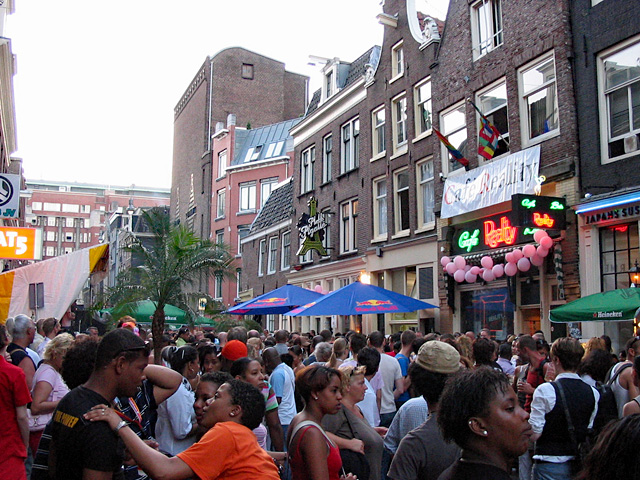
Caribbean street party at Reality Bar (2007)
The Kooistra venues
Initially, the main Gay Pride street party in Reguliersdwarsstraat was organised by Havana and April, from 2002 to 2006 by Bar ARC, and from 2007 by the company of bar-tycoon Sjoerd Kooistra, who owned most of the big gay venues in this part of the street. As such, he also spent a lot of money for big boats to participate in the Canal Parade.
But in 2009, Kooistra got financial problems, and for the first time his gay bars weren't able to provide a boat for the parade. Also the street party wasn't that spectacular anymore. In the Summer of 2010, Sjoerd Kooistra went bankrupt and committed suicide. But the show had to go on, so the Heineken brewery set up that year's Gay Pride street party:
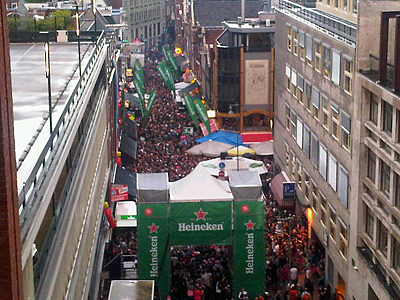
Gay Pride street party between April and ARC,
as seen from the Carlton Hotel (2010)
(photo: Benjamin van Es)
Limitations
After 2010, the street party in the western part of Reguliersdwarsstraat was organized by a combination of varying gay and straight bar owners, but they had to cope with increasing costs arising from stricter safety regulations. One of the results is that, since 2011, the Gay Pride street party has to be closed off by fences, when a maximum of 4500 visitors are in.
The growth of street parties and outside taps in the rest of the city center was also capped. Not much later, the city government stepped down from the ambition to be a leading "Gay Capital" in favor of being an attractive "Gay Destination".
(video: Peter Eijking)
New elements
Since 2012, there is also a Pride Walk to demonstrate against foreign and domestic anti-gay violence. With this march, from Mercatorplein to the Homomonument on Westermarkt, yet another element from the traditional format of the Pink Saturday and the "Stonewall Gay Prides" was added to the Amsterdam Gay Pride.
Early 2013, it was decided that the pink flower logo would henceforth be used for all gay events in Amsterdam. Therefore, a new logo was designed for the Amsterdam Gay Pride (AGP) itself. It consists of the letters A, G and P, with roundings symbolizing the canal bridges. The colours are a reference to the rainbow flag:
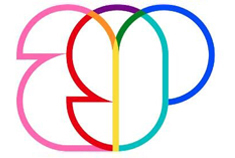
As of 2014, the Amsterdam Gay Pride again got a new organiser, this time the Amsterdam Gay Pride (AGP) foundation. They won the license for organising the event for at least the next three years, and decided to name it back into "Amsterdam Pride" after a reconciliation with the initial organiser GBA.
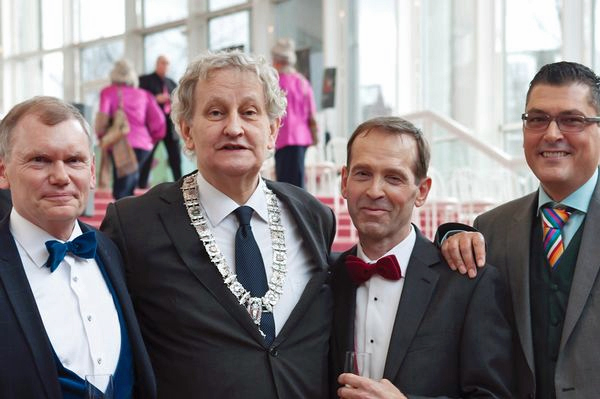
Mayor Van der Laan after honoring GBA board members Peter Kramer,
Siep de Haan and Ernst Verhoeven with the Andreas Medal
(photo: Barbara de Hosson/De Telegraaf)
EuroPride 2016
In 2016, Pink Saturday was back in Amsterdam, so for the first time since the Amsterdam Pride was established in 1996, both Gay Prides were held in the same city. Just like in 1994, Amsterdam also got the honour to celebrate this as EuroPride.
This triple gay event encompassed two weeks of events, parties and other activities. For the first time there were also big parties on the central Dam square and the Austrian winner of the Eurovision Song Contest, the popular drag queen Conchita Wurst, acted as international ambassador.
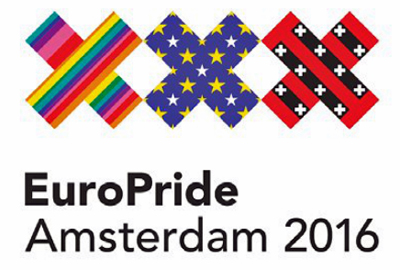
Corona pandemic
As a result of the corona pandemic, almost all activities of Pride Amsterdam for 2020 had to be canceled, including the street parties, but also the Pride Walk and the 25th edition of the Canal Parade, although the organizer said it was just "postponed" to next year. For this purpose, the city government extended the license with one year.

In 2021, the Amsterdam Pride celebrated its 25th anniversary, but despite a large-scale vaccination campaign, the corona danger had not yet passed and the anniversary could only be celebrated in a very limited form. Again, there were no street parties and Canal Parade, but the Pride Walk took place again on Saturday, August 7.
Reguliersdwarsstraat attracted many extra visitors on that Saturday, even without a street party, so that the street had to be temporarily closed in the evening. The corona regulations prescribed that people were only allowed to sit at tables in fixed places and had to keep 1.5 meters distance to each other.
Links
- Current homepage: www.pride.amsterdam

- Former homepage from 2002: www.amsterdampride.nl
- Pink Saturday: www.rozezaterdagen.nl
- EuroPride: www.epoa.eu

- Wikipedia: Amsterdam Gay Pride

- Medium.com: 20 years Amsterdam Gay Pride










